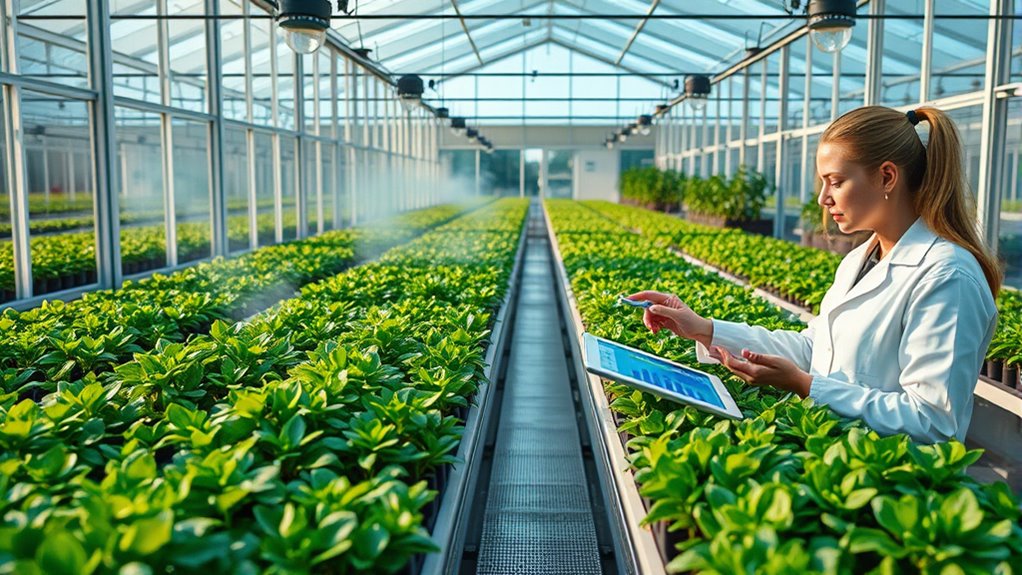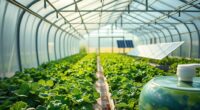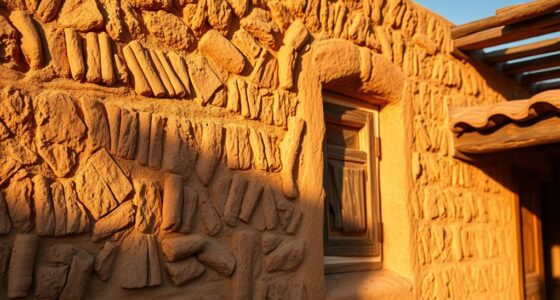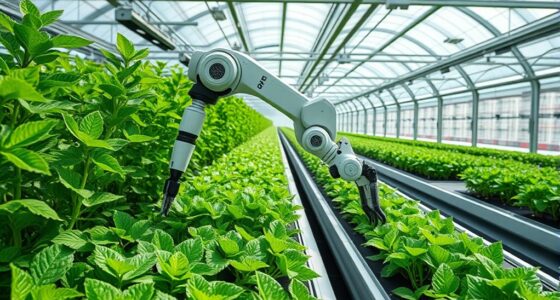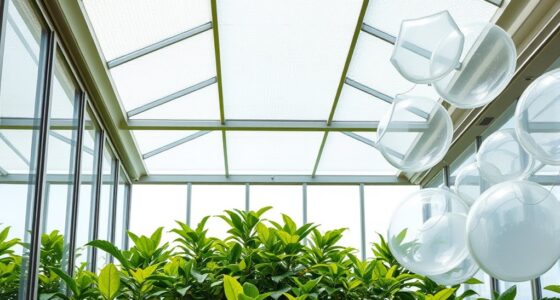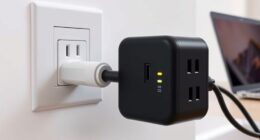By integrating IoT in your greenhouse, you gather real-time data on temperature, humidity, soil moisture, and light levels, allowing you to make precise adjustments automatically. This data helps you optimize environmental conditions, conserve water, and reduce energy costs. Automated systems respond instantly to sensor inputs, preventing plant stress and improving yields. When you analyze these insights over time, you can develop smarter management strategies. Keep exploring to discover how this technology can transform your greenhouse operations.
Key Takeaways
- IoT sensors collect real-time environmental and soil data to monitor conditions precisely.
- Automated systems adjust climate and irrigation settings based on sensor data for optimal plant growth.
- Remote access and alerts enable quick responses to environmental changes without physical presence.
- Data analysis supports proactive decision-making, optimizing resource use and improving crop yields.
- Integrated IoT solutions lead to sustainable greenhouse management through efficient, data-driven operations.
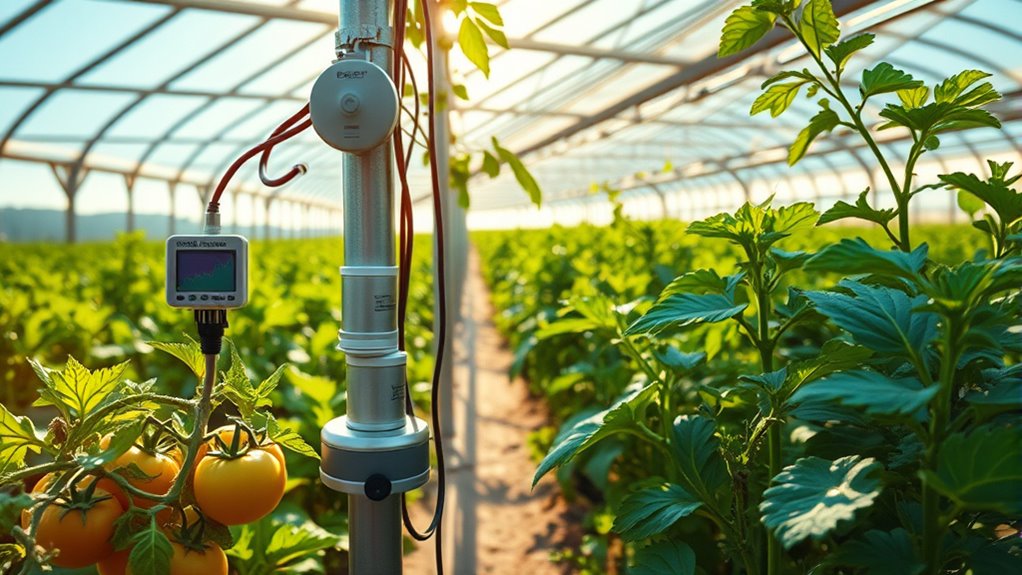
The integration of IoT technology in greenhouses is revolutionizing how we grow and manage plants. With smart sensors and connected devices, you gain real-time insights into the environment, allowing you to enhance conditions for healthier, faster growth. One of the most significant benefits is climate control. Sensors constantly monitor temperature, humidity, light levels, and CO2 concentrations, providing you with precise data. Instead of manually adjusting heaters, fans, or shading, you can automate these systems based on sensor readings, ensuring the environment stays within ideal ranges. This not only improves plant health but also reduces energy consumption and operational costs. You can set parameters once, and IoT systems will maintain ideal conditions automatically, giving you peace of mind and freeing up time for other tasks. Climate optimization is further improved by the ability to analyze environmental data trends over time, enabling smarter decision-making.
Irrigation management also becomes more efficient with IoT. Soil moisture sensors relay real-time data about the water content in your growing medium. Instead of relying on fixed schedules or guesswork, you can precisely water plants when they need it, avoiding over- or under-watering. This tailored approach conserves water, minimizes waste, and prevents disease caused by excess moisture or drought stress. Automated irrigation systems can be programmed to deliver the right amount of water at the right time, responding dynamically to weather changes or plant requirements. This level of control helps you maintain consistent growth conditions, leading to higher yields and better-quality crops.
Furthermore, IoT devices enable you to view and analyze data remotely via smartphones or computers. This accessibility means you’re not confined to the greenhouse to make adjustments. If a sensor detects a sudden temperature spike or drop, or if soil moisture drops below a threshold, you receive instant alerts. You can then intervene immediately or set the system to respond automatically, preventing potential damage. Over time, the data collected helps you identify patterns and optimize your climate control and irrigation strategies further, making your greenhouse more sustainable and productive.
Frequently Asked Questions
How Secure Is Iot Data in Greenhouse Environments?
IoT data in greenhouse environments can be quite secure if you implement strong cybersecurity measures. You should prioritize data privacy by using encryption, regular updates, and secure network protocols. Keep in mind that vulnerabilities exist, so staying vigilant and adopting best practices helps protect your data from cyber threats. Overall, with proper security strategies, you can confidently safeguard your IoT data in greenhouse settings.
What Is the Cost of Implementing Iot Systems in Greenhouses?
Implementing IoT systems in your greenhouse is like planting seeds for future growth, with costs varying based on your needs. A thorough cost analysis reveals that initial investments cover sensors, controllers, and connectivity, while ongoing expenses include maintenance and upgrades. You should consider these investment considerations carefully, weighing the benefits of optimized climate control and resource savings against upfront costs to guarantee your smart greenhouse flourishes sustainably.
Can Iot Help Optimize Water Usage in Greenhouses?
Yes, IoT can substantially enhance water usage in greenhouses. By using sensors with high sensor accuracy, you can monitor soil moisture and environmental conditions in real-time. This data allows you to adjust watering schedules precisely, enhancing water efficiency and reducing waste. Implementing IoT solutions guarantees your greenhouse conserves water while maintaining ideal plant growth, making your operations more sustainable and cost-effective.
How Does Iot Improve Pest Management Strategies?
You might wonder if IoT can improve pest management strategies. It does by enabling pest detection through sensors that monitor environmental changes and identify pests early. This real-time data allows you to act swiftly, applying targeted pest control strategies precisely where needed. IoT streamlines pest management, reduces chemical use, and minimizes crop damage, ensuring healthier plants and higher yields. It truly transforms traditional pest control into an efficient, proactive process.
What Are the Challenges of Integrating Iot With Existing Greenhouse Infrastructure?
You’ll face challenges integrating IoT with your existing greenhouse infrastructure, especially with legacy systems that may not support new technologies. Interoperability challenges can cause communication issues between devices, making data collection and automation difficult. Upgrading or replacing outdated equipment is often necessary, which can be costly and disruptive. To succeed, you need a well-planned strategy that addresses compatibility issues and guarantees seamless integration of IoT solutions into your current setup.
Conclusion
As you harness the IoT’s web of sensors and data, you become the gardener of a digital Eden. Each decision you make is a seed planted in the fertile soil of information, growing into flourishing plants of productivity and sustainability. Remember, the true power lies in your hands—guiding the unseen roots beneath the surface, nurturing growth from data’s silent whispers. In this interconnected world, you hold the key to a greener, smarter future.
